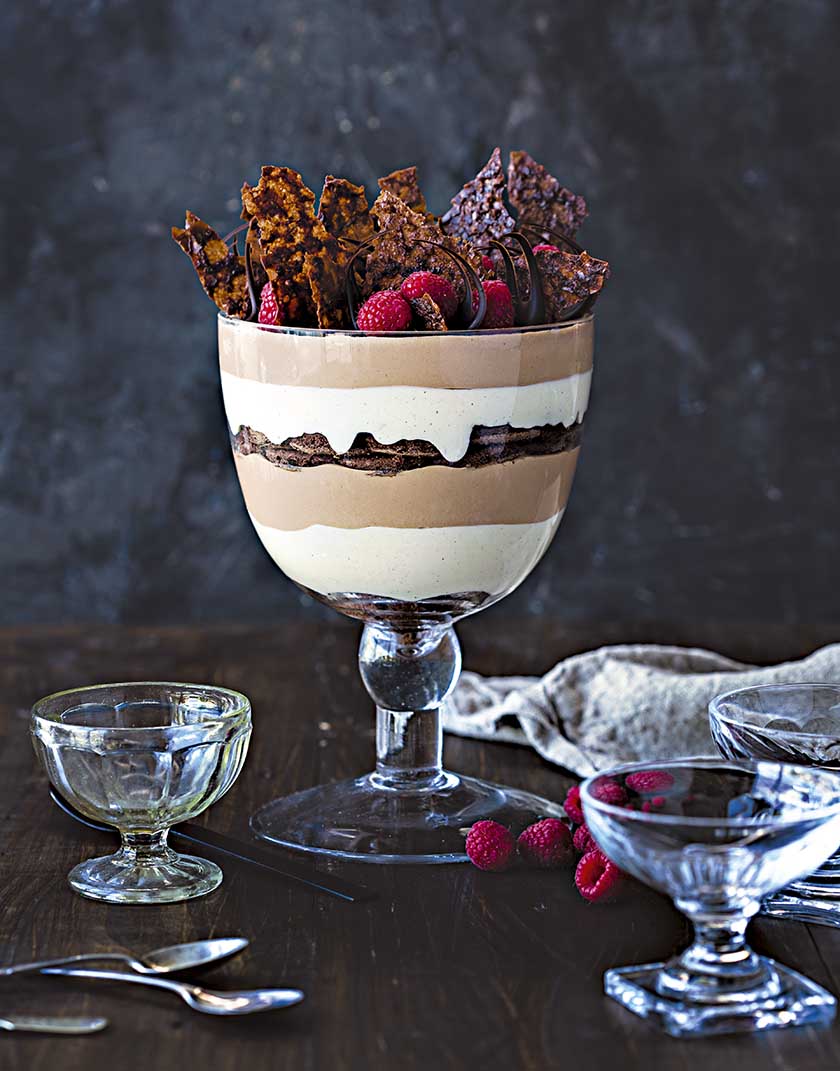Get Premium access to all the latest content online
Subscribe and view full print editions online... Subscribe
Serves 12 Desserts and puddings
This recipe calls for Dutch process cocoa powder, which has been treated with an alkalising agent to modify its colour and gives it a milder taste compared to natural cocoa. It is readily available in supermarkets. The chocolate used is dark couverture, which can be purchased online.
The trifle bowl in this recipe holds 1.5 litres. You will also need a sugar thermometer, 40cm x 30cm baking tray and paper piping cone.
To make the sponge, preheat the oven to 165C/320F/Gas 3 and line the baking tray with a non-stick silicone mat or baking paper. Using an electric mixer with a whisk attachment, beat the egg yolks and 70g of the sugar until light and creamy. Set aside.
In a separate clean bowl, whisk the egg whites and cream of tartar until medium peaks form. Gradually add the other 75g sugar and continue mixing for 1 minute to dissolve the sugar.
Sift the cocoa powder and cornflour on to the baking paper. Melt the chocolate in a double boiler or in a plastic bowl in the microwave in 20-30-second intervals, mixing well in between, until all the chocolate is melted.
Fold the sifted dry ingredients and melted chocolate through the egg yolk mixture. Gently fold into the whisked egg whites and pour on to the lined baking tray. Place in the oven for 12-14 minutes.
To determine when it is baked, press gently on the surface and it should bounce back. Remove the sponge from the oven and leave on the tray to cool.
Cut 4-5cm crescent shapes using a glass or round cutter (first cut out a circle, then again to create a crescent shape).
To make the cocoa arabesque, preheat the oven to 170C/325F/ Gas 3 and line 2 baking trays with a non-stick silicone mat or baking paper. Mix together the icing sugar, orange juice and warm melted butter in a bowl. Add the cornflour and cocoa powder and combine without over-mixing. Spread the mixture out thinly over the trays using a palette knife. Bake for 10-12 minutes then leave on the trays to cool. Test a piece – once cool it should snap. If it is elastic or stretchy, put it back in the oven for a few minutes.
For the Chantilly cream, put the cream, sugar and vanilla bean paste in a mixing bowl and whisk until the cream just holds its shape. Store in the fridge for up to 1 hour before assembling the trifle.
For the decorations, temper the chocolate (see chocolate fudge wheels recipe, right) then place it in a paper piping cone and pipe a dollop at a time on a sheet of baking paper.
Using the base of a teaspoon, swipe outwards in a curve from the centre of the chocolate then leave the decorations to set at room temperature for 30 minutes. If your room temperature is above 22C, place the decorations in the fridge for no more than 5 minutes.
To make the mousse, whisk 320ml of the cream until it just holds its shape. Set it aside in the fridge. Put the chocolate in a heatproof bowl. Whisk the egg yolks and sugar in a bowl. Put the milk and remaining 85ml cream in a saucepan over a medium heat and bring to the boil then pour it over the egg yolk mixture and whisk to combine. Return the mixture to the pan over a low heat, stirring gently until the temperature reaches 82C, to create an Anglaise.
Once it is ready, immediately strain it over the milk chocolate, whisking until it is melted. Fold through the semi-whipped cream. Use the mousse straight away.
To assemble, start by placing one-third of the sponge crescents that will lock in together in the base of the trifle bowl. Top with a layer of cocoa arabesque. Cover with half the Chantilly cream and half the mousse. Repeat the process and place the trifle in the fridge for a minimum of 2 hours.
Just before serving, garnish the top by sticking the remaining broken pieces of cocoa arabesque and the tempered chocolate garnishes into the mousse and scatter fresh raspberries on top.

Advertisement
Subscribe and view full print editions online... Subscribe